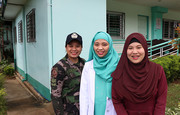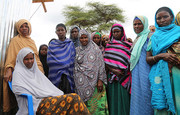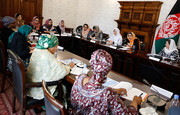UNFPA works closely with governments, UN agencies and other partners to ensure that reproductive health is integrated into emergency responses. UNFPA deploys hygiene supplies, obstetric and family planning supplies, trained personnel, and other support to vulnerable populations, and works to ensure the needs of women and young people are served through both an emergency and the reconstruction phase.
Heightened vulnerabilities
Even under normal conditions, reproductive health issues are a leading cause of death and illness among women of childbearing age. When a crisis strikes, skilled birth attendance and emergency obstetric care often become unavailable, exacerbating the vulnerability of pregnant women.
Women face other threats as well. The absence of health services and other factors can increase the risks of contracting HIV and other sexually transmitted infections. And the breakdown of protection systems often leads to a rise in gender-based violence. In addition, the burden of care women assume for children and others can make it difficult for them to take proper care of themselves. Women may neglect their own needs as they care for their families and neighbours.
UNFPA in emergencies
Antenatal, safe delivery and post-partum care: UNFPA’s emergency response includes supplies for prenatal care; clean delivery kits to help prevent infections among women who cannot reach a medical facility during delivery; equipment and medicines for clinical deliveries; supplies for emergency obstetric care; and support to address post-partum complications that can arise for both mothers and newborns. UNFPA also provides on-the-ground training for health workers and midwives.
Responses are tailored to the circumstances of each crisis. Ad hoc delivery rooms may be set up in damaged buildings, mobile health clinics may be dispatched, and midwives are sometimes provided with motorcycles. More comprehensive services are organized when the worst of the crisis has passed.
Family planning: Many couples want to avoid pregnancy and childbearing during crisis situations, but lack the means to do so. The absence of voluntary family planning in emergencies means higher risks of unintended pregnancies, greater health risks for pregnant women, and possible health consequences for those who resort to unsafe abortions. Restoring access to safe, effective contraception protects the lives and well-being of women and enables crisis-affected couples to manage scarce family resources more effectively.
UNFPA ships male and female condoms and other family planning supplies to affected areas within the first hours of an emergency. When the situation stabilizes, UNFPA conducts rapid assessments to determine local needs and preferences and supports efforts to make a wide range of modern contraceptive methods available.
Hygiene: The specific hygiene needs of women and girls are too often overlooked in emergencies. To help women and girls maintain their health and dignity, UNFPA distributes 'dignity kits' in disaster- and conflict-affected communities. These kits contain menstrual pads, soap, underwear, as well as other supplies required by circumstances or cultural contexts. For example, headscarves are distributed in some communities, while t-shirts are provided in others. In places where women and girls fear assault, for example while traveling at night to the toilets, torches with batteries are included in the kits.
Addressing gender-based violence
UNFPA addresses gender-based violence in humanitarian settings with a wide range of services, including counselling, post-rape treatment, legal support, assistance with livelihoods, and support through its sexual and reproductive health programmes. UNFPA also incorporates violence prevention in its humanitarian response, reaching out to vulnerable adolescents and youth, sending messages to men and boys about gender equality, and working closely with faith-based networks and cultural leaders to reinforce support systems.
Since 2005, UNFPA has co-led, with UNICEF, the Gender-Based Violence Area of Responsibility of the Global Protection Cluster, which oversees the humanitarian community’s response to gender-based violence. UNFPA also works to strengthens services, information and referral systems for survivors, and helps develop the capacity of partners to effectively design, manage, and evaluate programmes to address gender-based violence in emergencies. For example, the Fund establishes systems for improved management of gender-based-violence-related data through the Gender-Based Violence Management Information System, and supports the interagency GenCap initiative, which deploys gender advisors to emergencies on short notice.
Young people
Young people often represent a large proportion of those affected by crises. In some countries, two thirds of the population is under 25, and half of the world's out-of-school children live in conflict or post-conflict countries. Displaced young people are particularly vulnerable to HIV, and they urgently need information and services to protect themselves from disease and unintended pregnancies.
UNFPA places a high priority on safeguarding young people's well-being and supporting their successful transition to adulthood. UNFPA raises awareness of and addresses the specific needs and concerns of young people affected by war or crisis, often using innovative and participatory approaches.
Data collection
UNFPA plays a critical role in collecting data during emergencies. These assessments help guide crisis responses, enabling humanitarian organizations and affected populations to better understand how needs are evolving under rapidly changing circumstances. UNFPA is uniquely well suited to perform this work. The Fund collaborates with national statistical organizations in developing and middle-income countries, facilitating the collection, analysis, dissemination, and use of reliable data and information. UNFPA also has a wealth of experience, from the country and regional levels to the global level, on population and development issues.
UNFPA collaborates in humanitarian programming through the Inter-Agency Standing Committee, the mechanism for coordinating humanitarian assistance. UNFPA also issues guidance on issues involving data collection during humanitarian crises.




